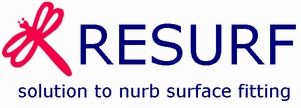

|
| Home | Products | Purchase | Change log & Road map | Gallery | Support | Download | Contact | 中文 |
Home > Documentation for RhinoResurf Table of Contents 1. Introduction
2. Command Reference
|
RsFillHoleBySurf
Command description: This command helps user fill the hole surround by patches. User selects the surface edge or curves to create a trimmed NURBS surface, the surface can be set G1 continuous to neighbor patch on the boundary.
1. Surface edge or curve can be picked as boundary lines to construct surface. When picking the boundary, the G0 or G1 continuity type on the boundary can be defined, and the surface will be solved under these continuity constraints; 2. User can pick curves or point sets as interior data constraints, the surface can be deformed to the position of the interior data; 3. When fitting the surface to the interior data, the boundary line can be selected to remain unchanged, the position (G0) and normal vector(G1) on the boundary line can be kept; 4. By using the "Add knot " button and "Refine" button, user can improve the error (G0 or G1) accuracy of surface approximation; 5. The deviation of position and normal vector on the boundary line can be viewed; 6. Support to pick the boundary lines of multiple loops to construct trimmed surface; Video:
If the above video is invalid, please click here to download the video To fill the hole with surface:
4. Click Apply to create surface. Dialog description:
Tutorial: Fill hole with surface G1 continuous to neighbor patch.
|
Copyright (C) 2007-2012 RESURF All Rights Reserved. Privacy Statement |